Judex
[DVD]
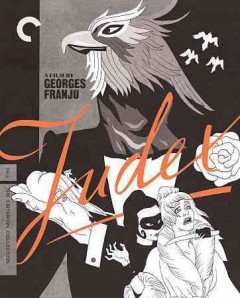
view/request
I tend to be someone who knows what he’s looking for in the stacks and will often go in with a list. We can’t always be a slave to structure though. Judex is a film I checked out based solely on the intriguing box cover. It also is a part of the Criterion Collection… so, I knew I was in for something interesting.
This 1963 French movie is an homage to a 1916 silent film of the same name. Set at the time of the original, Judex hits the ground running with a mysterious blackmail letter, a murder, strange sci-fi/occult touches and a stoic, caped man. Countless twists and turns, masks, hidden identities, a circus, knives and a lovable detective color this suspenseful caper. Furthermore, Judex is photographed in the most brilliant black and white with stylish camera angles that would make any film nerd’s heart have serious palpitations.
It pays to sometimes take chances with movies; going in blindly. However, I’ve done the work for you already on this one. So, go ahead and enjoy George Franju’s Judex!
Reviewed by Jason
Tagged: Feature film, Mystery
Inherent Vice
by Thomas Pynchon
[Audiobook]
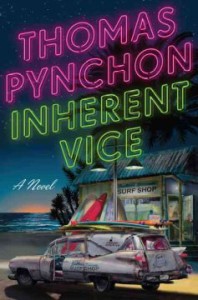
view/request
Ron McLarty narrates this bizarre and wonderfully entertaining crime novel by Thomas Pynchon. Infusing the perfect hippie bravado to our central character Doc Sportello, McLarty transports us to this far out time.
Filled with film and music references, original music (sung a capella by McLarty on the audiobook), hilarious dialog and a gritty tone, Pynchon creates a unique take on the detective novel. Doc, who is a long haired, stoner private-eye in Los Angeles at the close of the 1960’s, is on the case to find a missing ex-girlfriend. Along the way, he has run ins with colorful characters in this backdrop of groovy pads, surf music and drug culture.
Flower power is over and something darker is on the horizon.
Reviewed by Jason
Tagged: Fiction, Mystery
Show Me the Magic
by Paul Mazursky
[Book]
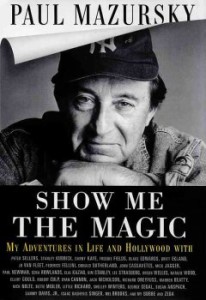
view/request
riter/director/producer/actor Paul Mazursky’s autobiography is an anecdotal collection of Hollywood tales, international adventures and reflections on growing up in Brooklyn. A real page turner, too! I ignored those around me and read this cover to cover in two evenings. Mazursky, who directed classics such as Bob and Carol and Ted and Alice, Blume in Love, Tempest, Moscow on the Hudson and An Unmarried Woman, has plenty of interesting tales to share.
The author recalls showbiz run-ins with Stanley Kubrick (Mazursky’s first major acting role was in Kubrick’s Fear and Desire), Orson Welles, Peter Sellers, George Segal, John Cassavetes, Gena Rowlands, Warren Beatty and Natalie Wood among others. What’s possibly the most fascinating is his relationship with Federico Fellini. It’s a touching friendship and their meeting is something of legend. In addition, Mazursky includes several letters from the great Italian film director in his book.
The title “Show Me the Magic” comes from one of the most exciting pieces of cinema history; a piece of dialog from Mazursky’s adaptation of Shakespeare’s The Tempest. Forever imprinted in my mind is the scene where John Cassavetes conjures up a small miracle… in a film that plays it straight up until that point. An unpredictable moment on screen and perfectly fitting coming the mind of a man who lived an exciting and unpredictable life.
Reviewed by Jason
Tagged: Film, Memoir, Non-fiction
Sensation: The Story of Tommy
[DVD]

view/request
I first heard the Who’s Tommy as a teen or pre-teen after borrowing a copy from the Russell Library in Middletown, CT. That’s really the age to delve into both the angst and sensitivity of the Who… in fact, it’s the best time to explore music in general as that feeling of the world opening up to you begins. What followed this library trip was a huge Who obsession and, after the realization that Pete Townshend and I share a birthday, I was convinced there was some sort of connection between myself and the music. I’m sure I wasn’t the only teenager who felt this way.
Martin R. Smith’s documentary doesn’t focus on the stellar musicianship of the band (that coverage can be found anywhere… I mean, listen to a Who album!); rather, it leads the viewer through Tommy‘s high concepts and tells the story of a band in a state of transition. It is evident we have a “pre” & “post”-Tommy Who for the history books. Tommy, an album many consider as the first “rock opera”, legitimized Pete Townshend as a true composer, gave Roger Daltry the confidence to stand out front as the powerful lead singer (often in fringe), took the Who to opera houses around the world and turned the band into a stadium rock monster.
The film features interviews with Pete Townshend, Roger Daltry, John Entwhistle (archival), Keith Moon (archival), former Who manager Chris Stamp, Tommy album artist Mike McInnerney, Who biographers and a couple Rolling Stone Magazine nerds. It also has audio recordings of Townshend demos and several live performance clips.
Reviewed by Jason
Tagged: Documentary, Rock music
The Art of the Steal
by Don Argott
[DVD]
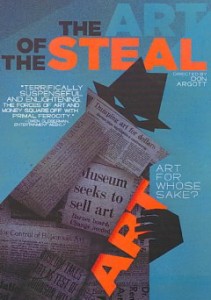
view/request
The Art of the Steal is a documentary that addresses the issue of public ownership of artwork. Don Argott’s film focuses on a much heated conflict in the state of Pennsylvania concerning the Barnes Collection and Foundation. Albert Barnes, a wealthy chemist turned art collector, acquired one of the most stunning Impressionist and Post-Impressionist collections in the world. He housed this uniquely curated collection along with a school as the Barnes Foundation in Lower Merion, PA. After his death in 1951, it was made clear by his will that the collection would not move nor would any of the work be sold under any circumstances.
Here’s where it gets interesting… Barnes’s wishes were not shared with many of the powerful Philadelphia politicians and society members. As management changed hands, the film highlights political nonsense and a long spiral of undermining of the collection’s owner over a sixty plus year period. Many issues arise in the dealings with the collection of art (now worth an estimated twenty-five billion dollars) and we really don’t have a clear cut understanding of whose interests are actually being served.
The Art of the Steal is a fascinating look into both the political and art worlds.
Reviewed by Jason
Tagged: Art, Documentary
What is Visible
by Kimberly Elkins
[Book]

view/request
Kimberly Elkins’ What Is Visible is one of the best books I have read in a long while. I wept through its final chapters, and yet, upon finishing it I find myself already sorry that I had reached the end so soon. A work of historical fiction, What Is Visible tells the story of a number of celebrated figures at the Perkins School for the Blind in the mid-nineteenth century, including Samuel Gridley Howe and Julia Ward Howe, but most of all, the remarkable Laura Bridgman, who, at the age of two, lost her senses of sight, hearing, taste, and smell. Although she relied almost completely on her sense of touch to perceive the world, Laura would learn English, and could read, so long as the print was raised so that she could feel the shape of the letters, could write, and conversed with others using a manual alphabet in which the two conversationalists would write or sign letters into each other’s hands.
A world without sight, sound, smell or taste is difficult for most of us to imagine, but, as this book shows, none of these senses are essential, and it serves us well to spend some time imagining a life without them. Each chapter of the novel is written from the perspective of a different character. Most are written from Laura’s perspective, but many are written from the perspective of Julia Ward Howe, the suffragist and poet, or from that of Laura’s teachers, including her most famous teacher, the abolitionist, educator, and phrenology devotee, Samuel Gridley Howe (who was also Julia’s husband). Elkins writes a compelling and moving portrait of each of these characters, and the story they tell together is both Laura’s story and a fascinating glimpse at a small portion of 19th century America life. The stories told here are full of hardship and melancholy, but also of hope and perseverance and occasionally even joy. They are the stories of remarkable people with remarkable ideas, and of how they did, and did not get along.
I loved this story and the way it was told, and I can say with confidence that this is a book I will want to reread. I don’t feel that way often.
Reviewed by Forbes Library Staff
Tagged: Fiction, Historical fiction
In One Person
by John Irving
[Book]

view/request
I’m glad I read John Irving’s In One Person, though I almost gave up on it in the first few pages. The rambling conversational tone took some getting used to, and the sexually explicit language did not yet seem justified. Something in the quirky characterization of the protagonist, Billy, kept me reading and as the conversational tone became familiar and Irving’s wonderful story telling took over, I soon found it difficult to put the book down.
What began as a strangely narrated story of a quirky child soon becomes an engaging coming-of-age story, then a touching examination of the life of a bisexual man in a world that is deeply uncomfortable with his bisexuality and the gender bending behavior of those he loves, and eventually a stark look at the AIDS epidemic in the 1980s.
Over the course of the novel John Irving illustrates the changing attitudes towards cross-dressers and transwoman in American society from the 1940s until the turn of the millennium. While his portraits are certainly not representative they are believable and always sympathetic.
There is nothing titillating about In One Person despite its sexually explicit language and themes. This is a story about friendships, crushes, prejudice and acceptance.
Reviewed by Forbes Library Staff
Tagged: Coming-of-age, Fiction, LGBTQ
Bach Unaccompanied Cello Suites
by J.S. Bach; performed on double bass by Edgar Meyer
[Music CD]
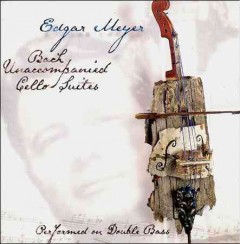
view/request
This is one of the most amazing CDs I have ever heard. Edgar Meyer is a musician’s musician who is in high demand in the classical, folk and bluegrass worlds. He has partnered with the likes of Yo-Yo Ma, Joshua Bell, Bela Fleck and Mark O’Connor, and he composed a violin concerto for Hilary Hahn. Here he partners with Johann Sebastian Bach in a new interpretation of the suites for solo cello with a much deeper voice. He solves the technical problems of the bass — larger reach and slower-speaking strings, for example — with a technical mastery that is just mind-boggling. But this is not just virtuosic fireworks. The bass sings under his fingers. And you can hear the 30 years of practice and love for the repertoire in this recording. Meyer is right up there with Casals on my shelf.
Reviewed by Faith
Tagged: Baroque music
The Hangman’s Daughter
by Oliver Pötzsch
[Book]
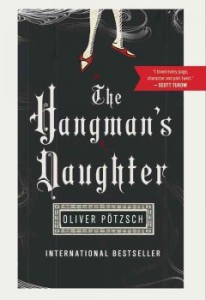
view/request
Whenever I go to New York City I make a pilgrimage to the Strand bookstore.18 miles of books, how could I not?! During my last visit I became overwhelmed, and after 45 minutes of wandering, snatched The Hangman’s Daughter from the “books everyone loves table.” To my surprise, the book was a lot of fun.
Originally written in German, this mystery novel set in 17th century Bavaria has both an interesting plot and a plethora of historical detail. When the body of a local child turns up in a river with suspicious markings, the townspeople assume dark magic is afoot. Despite the lack of tangible evidence, the town midwife is accused of witchcraft. Jakob Kuisl is an unlikely detective (oh, and the town hangman) who stands out as the voice of reason in a world that is ready to accept witch hunts and gruesome medieval medical practices. Can the hangman prove that the midwife is innocent before it’s too late?! You’ll have to read the book to find out.
Those critical of language and authenticity may find the translation too modern but I found it approachable. An engaging whodunit!
Reviewed by Lilly
Tagged: Fiction, Germany, Historical fiction, Mystery
Starstruck: Photographs From a Fan
by Gary Lee Boas
[Book]
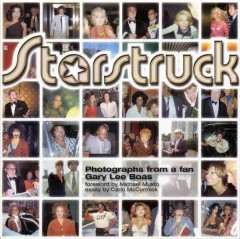
view/request
I’ve spent a considerable amount of time with the square amateur photo book that is know as Starstruck. I first discovered it in the little library of my friend’s basement/record studio. Often when someone is trying to get the tambourine part just right or the bass amplifier needs adjusting, I pick up a good book to browse… with pictures.
Starstruck is a collection of candid celebrity photos by Gary Lee Boas. The time frame ranges from 1966 (when the photographer was 15) until 1980. Boas was essentially an obsessed fan who would wait around Manhattan to catch stars going in and out of theaters, restaurants, clubs, etc. Although some shots are fairly washed out or rather out of focus, they’re all completely fascinating. There’s a charm to these shots and one can’t help but admire Boas’s obsession. Well, maybe “admire” isn’t the right word!
Even with images of massive celebrities like Katherine Hepburn, Michael Jackson, Jimmy Stewart or Jack Nicholson, the real star of this book is New York City. Accidentally, Gary Lee Boas gives us an excellent overall snapshot of the world’s greatest city at an electric time.
Reviewed by Jason
Tagged: 1970s, 1980s, New York City, Photography
Nilsson: The Life of a Singer-Songwriter
by Alyn Shipton
[Book]
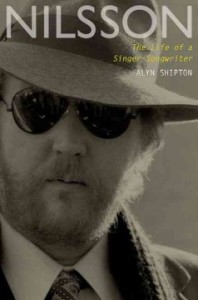
view/request
John Lennon once stated “Nilsson’s my favorite group.”
Harry Nilsson, the tenor with the golden, three and a half octave vocal range/the brilliant songwriter/the ultimate interpreter of songs/the boozer/the raconteur/the sometimes screenwriter, lived the most of his 52 years. His life was a colorful one that began with much sadness. Despite his setbacks and despair, Nilsson managed to keep his spirits high and he chose the path of adventure. He sang the theme song to Midnight Cowboy, released a brilliant run of albums from 1966-1980 (with music ranging from ballads to Beatlesy pop to country send-ups to wild rockers to standards from the Great American Songbook to Calypso to rude comedy numbers), conceived the animated children’s classic The Point!, collected a couple Grammy’s, raised hell with Ringo Starr and other music royalty, started a film production company and eventually settled as a family man.
Using a myriad of resources, interviews and quotes from Nilsson’s unfinished autobiography, Alyn Shipton writes a loving biography without sensationalizing the life of this sensational artist.
Reviewed by Jason
Tagged: 1960s rock music, 1970s, Biography, Music
Evocateur: The Morton Downey Jr. Movie
[DVD]
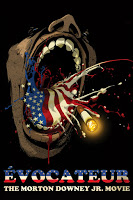
view/request
Saying Morton Downey Jr. was a complex man would be the understatement of the century. Son of a famous singer, Jr. began his career in show business as a vocalist himself. He had a small hit with in 1958 with the haunting tune “Boulevard Of Broken Dreams”. He later worked in radio and eventually became involved with the world of sports by first buying an American Basketball Association team and later co-founding the World Baseball League.
What brought Morton Downey Jr. national attention was his short run on the syndicated Morton Downey Jr. Show based out of New Jersey. The host who grew up hanging around the Kennedy family, became a loudmouth, conservative screamer on his late 80’s program. The documentary pulled many clips that made the air where Downey Jr. gets in audience members faces and says some of the most horrific and offensive things you will ever hear in your life. His show seems to be pure theater and unfortunately it paved the way for future trash television such as the Jerry Springer Show.
Like him or not, Evocateur is a massively entertaining film. It’s an excellent documentary of the strange life and quick rise and fall of a man whose life was filled with controversy.
Reviewed by Jason
Tagged: Documentary, Politics












